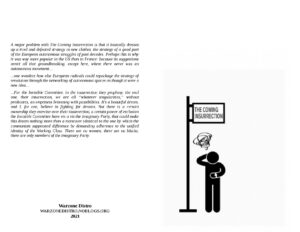
“At this point, many anarchists in the US are already familiar with how tiqqunists destroyed the struggle at the Notre-Dame-des-Landes ZAD (Zone to Defend) occupation in France in favor of legalization and property ownership [1]. The narrative that this tragic conclusion to the decade-long struggle was actually a victory has been regurgitated ad nauseum by tiqqunist platforms in the US. For example, Ill Will Edition’s “The Strategy of Composition” is about applying this “strategy” to the struggle against Cop City: “The territorial phase of the struggle took shape gradually over a ten year period from 2008 until its eventual victory in 2018, and has since continued to nourish collective experiments on the Zone to this day”.
The next initiative of the ex-ZAD tiqqunists failed when those familiar with their methods of recuperation and authoritarianism sabotaged their attempts to take the vanguard of a ZAD located in Carnet. Comrades from the Carnet ZAD along with those from several other struggles co-authored a statement outlining the attempts at cooptation and centralization, which we included as an appendix in this zine as an inspiring example of anti-authoritarians making a struggle inhospitable to authoritarian power plays.
After this failed attempt at bringing autonomous and decentralized struggles under their control, the tiqqunists of the ex-ZAD moved on to their most recent initiative: Soulevements de la Terre (which translates to “Earth Uprisings”, aka SDT). Exploiting the momentum of groups like Extinction Rebellion, and the broader youth climate movement, SDT offers activists a militant alternative to civil disobedience: mass demo-actions against ecologically destructive targets. While these have included some notable acts of sabotage, it is important to notice that their actions are often just as limited to symbolic engagement as those of the non-violent environmentalists, designed to promote the organization through sensationalism aimed at capturing the attention of the mass media. A recent mass action against a water basin on March 25th resulted in serious injuries, prompting anarchists to more broadly articulate warnings about this organization’s political foundations and motivations. The authors of these texts are careful to critique the centralized forces behind SDT and not the participants, clarifying that they are not telling anyone to stop attending SDT actions, but rather encouraging them to maintain a critical eye towards how the actions are organized and what they are being asked to do.
Predictably, the two primary tiqqunist platforms in the US have championed Soulevements de la Terre: Ill Will Editions republishes their propaganda, and Inhabit does the same while proclaiming that their actions are “an exhilarating example of all that has gone well in the movement up until this point and chart a path forward we hope others can imagine walking themselves”. [2] The following three critiques from anti-authoritarians in France are therefore also relevant to our context. These texts focus on manipulative and vanguardist practices, the spectacularization of the struggle, and the use of radicals as shock-troops. The goal of these texts, and our translation effort, is to increase familiarity with these deceptive practices and strategies, an essential first step towards sabotaging the influence and control of any similar attempts in our own neck of the woods.”
BREAKING RANKS_Subverting the Hierarchy & Manipulation Behind Earth Uprisings pdf


